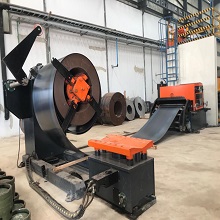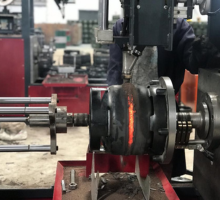Production Process and Lines
Our Production Lines
Surge has invested in technologically advanced LPG manufacturing facility with a fully automated manufacturing lines of Turkish origin.
The production machinery plays a vital role in ensuring Surge production is efficient and effective. LPG Cylinder Production is composed of several steel forming, surface treatment, finishing and testing processes.

The Cylinder Body Forming Line
This involves de-coiling, straightening, blanking, embossing as per client requirement, deep drawing, trimming and joggling, degreasing, welding so as to form the cylinder.

Guard (Collar) Ring Production
The guard ring protects the valve from damage, which is the most sensitive part of the LPG cylinder, and enables easier handling of the cylinder. The guard ring makes it possible for cylinders to be stack upon each other for easier transportation and storage.

Bottom Ring Foot Ring Production
The bottom rings help prevent the damage of LPG cylinders from the bottom. The bottom rings enhance storage and transportation as the cylinders can easily stack on each other. The designs are according to the customer’s needs and in line with ISO/KEBS standards.

Welding line
This is carried out by fully automated machines. Two complete halves are welded together as one piece to maintain consistent welding in the joints and form a complete cylinder. The process is carried out meticulously to ensure that the two halves are safely welded together with the submerge arch welding as per ISO standards.
Besides the body welding, flange welding ( SAW) , guard ring, and foot ring welding are also carried out at this stage where they are welded into the main body of the cylinder.

Heat Treatment Furnace Line
The cylinders pass through the oven from entry to exit side on a conveying system for proper heat treatment process between 875 °C to 920 °C of temperature including preheating, heating and cooling steps. This step is critical as it works to relieve all the stresses caused by the cylinder forming and welding operations.

Hydrostatic Test Line
The hydrostatic testing is carried out on the heat-treated LPG cylinders by increasing the internal pressure up to 35 bars to aid in visual inspection for any leakages or if the sheet material has some holes/cracks on it as a defect.

Shot Blasting Line
The shot blasting machine is used to clean the surface of the LPG cylinders before zinc and paint works.

Metallization Line
This involves zinc spraying of the cylinders to aid in corrosion protection and therefore increases durability and overall lifetime of LPG Cylinders. Cylinders go under the process within the standard time after the shot blasting.

Painting Line
We do powder painting and our surface coating line has the capacity to coat approximately 550 cylinders in an hour. After completion of powder coating, it will go to the paint curing.

Valving and Pneumatic Line
We clean the cylinder with vacuum before valving since it is important for long life of cylinder.
After successful valving, the cylinders are tested against any leakage at the body or the valve region using the pneumatic testing at the final stage.

Screen Printing Line
Using the approved customer brand name and/or logo, screen printing is done at the agreed parts of the cylinder body.

Documentation and dispatching
All the document including country of origin (COO), EAC, Test repots, and Serial numbers etc will be provided upon request with the delivery.
The Production Process






















